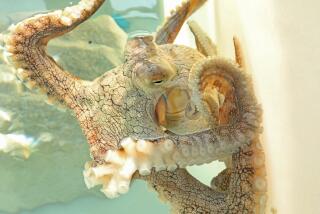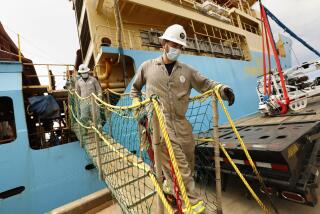Japanese Oyster Sparks Dispute on Revival of Chesapeake Bay Harvest : Environment: Critics say the imported bivalve could finish off native shellfish decimated by disease. They cite the killer bee as a species with unwelcome consequences.
- Share via
A proposal to plant 600 tiny Japanese oysters in the Chesapeake Bay has spawned a dispute between Virginia and Maryland over whether the idea for reviving the bay’s declining oyster population could turn into an environmental disaster.
A Virginia advisory panel recently gave scientists a tentative go-ahead to introduce the Pacific oysters into the York River to see whether they resist two diseases killing native species.
The experiment has split the scientific community, watermen and officials in the two states. Supporters paint the Pacific species as potential salvation for a dying local industry and an ecological boon for the bay, because oysters filter dirty water and build reefs that other creatures live on.
But critics, including environmental groups, fear that the imported species would push aside the native bivalve, which they are not ready to give up on yet. Calling the Pacific species “marine kudzu,” they say it would bring the same risks of disease or other unwelcome consequences as any new species--killer bees, gypsy moths and Norway rats, for example.
“There are a substantial number of scientists who think it could be a catastrophe,” said William Goldsborough, a Chesapeake Bay Foundation scientist who served on the advisory panel and voted against the oyster experiment. “It’s unpredictable. You just don’t know what’s going to result.”
“What have you got to lose?” asked Roger Mann, the Virginia Institute of Marine Sciences oyster biologist who is the proposal’s chief academic sponsor.
Quoting an Australian scientist who called the state’s oyster industry a “museum piece,” Mann said strict safeguards would be taken to reduce risk. He also countered with his own list of beneficial imported species--corn from Central America, for example.
The meat of the Pacific oyster looks and tastes no different from that of the Chesapeake oyster, supporters say. Some critics say the Chesapeake brand is better, and they describe the import’s shell as “snappy,” waterman slang for long and skinny. In fact, most oysters sold locally are the imported Pacific variety because the Chesapeake variety is scarcer and more expensive.
Estimates are that the Chesapeake Bay, once the world’s leading source of oysters, now has only 1% of the harvest it once did. The blame is placed on greedy harvesting, environmental deterioration and two diseases, dermo and MSX, that have been ravaging the native oyster stock.
In Virginia, which had million-bushel harvests 40 years ago, barely 135,000 bushels were pulled in last year, a record low. Maryland is in better shape, although its 400,000-bushel harvest also is down from previous years.
Oysters, once Virginia’s leading sea crop, brought in only $4.7 million last year, a sixth of what sea scallops produced. Oysters simply will not grow in vast areas of Virginia’s middle bay, officials say, estimating that only 1% of the 240,000 acres of public harvest ground actually is being harvested.
The York River, where Mann wants to run his experiment, has had virtually no harvest in decades. He proposes taking oyster stock from his lab, where it has been growing in quarantine for three years as protection against disease, and altering its chromosomes to lower, although not eliminate, the possibility that it will reproduce. Then he would drop the oysters overboard and see if they survive dermo, which they resist in the lab, and MSX, which cannot be cultivated in the laboratory, he said.
Recently, his idea was approved by a panel of scientists, political figures, watermen, oyster processors and others who were appointed by state officials last year after Mann’s proposal was rejected by the Virginia Marine Resources Commission. That rejection came after fierce criticism from environmentalists, scientists and watermen.
“The risk of any damage to the bay is minimal to nonexistent,” said former Virginia governor Linwood Holton, a panel member.
The panel said studies should be done first of the potential overlap between the Pacific and native species and of the underwater environment in which the Pacific oyster thrives.
The panel also made several other recommendations to revive the oyster industry, including some unusual steps that would allow harvest of oysters from areas now closed because of pollution. That harvest would include moving oysters from polluted waters to cleaner areas of the bay, where they would rid themselves of contamination and then be harvested.
The recommendations now go to Virginia’s commissioner of marine resources, and a public hearing will be held before he decides.
Maryland and other Atlantic Coast states already are lined up to oppose the proposal. Maryland reasons that it has a pretty good harvest with the native oyster, so it does not want to risk an intruder. Mann said he expects a lawsuit from Maryland if Virginia goes ahead.
“If you bring it to Virginia, there’s nothing to keep it from spreading from Florida to Maine, and those states should have some say,” said George Krantz, a scientist who directs Maryland’s Oxford Cooperative Laboratory. “Once the thing gets loose, there’s no reversing it.”
Krantz has drafted a resolution to be considered by the Atlantic States Marine Fisheries Commission, an advisory group made up of representatives of states from Maine to Florida. It urges an economic impact statement and thorough risk assessment before any open-water experiment.
Opinion among watermen is divided, said Tommy Leggett, vice president of the Virginia Working Watermen.
“There are watermen who are scared of what it will do to our native oyster,” said Leggett, who harvests the lower Potomac.
More to Read
Sign up for Essential California
The most important California stories and recommendations in your inbox every morning.
You may occasionally receive promotional content from the Los Angeles Times.










